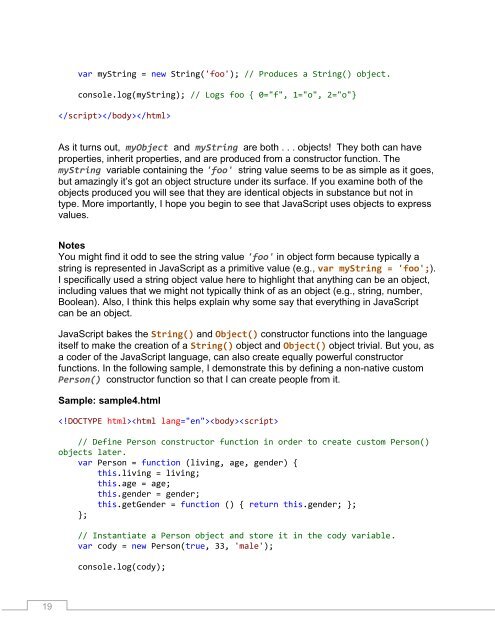JavaScript_Succinctly
You also want an ePaper? Increase the reach of your titles
YUMPU automatically turns print PDFs into web optimized ePapers that Google loves.
var myString = new String('foo'); // Produces a String() object.<br />
console.log(myString); // Logs foo { 0="f", 1="o", 2="o"}<br />
<br />
As it turns out, myObject and myString are both . . . objects! They both can have<br />
properties, inherit properties, and are produced from a constructor function. The<br />
myString variable containing the 'foo' string value seems to be as simple as it goes,<br />
but amazingly it’s got an object structure under its surface. If you examine both of the<br />
objects produced you will see that they are identical objects in substance but not in<br />
type. More importantly, I hope you begin to see that <strong>JavaScript</strong> uses objects to express<br />
values.<br />
Notes<br />
You might find it odd to see the string value 'foo' in object form because typically a<br />
string is represented in <strong>JavaScript</strong> as a primitive value (e.g., var myString = 'foo';).<br />
I specifically used a string object value here to highlight that anything can be an object,<br />
including values that we might not typically think of as an object (e.g., string, number,<br />
Boolean). Also, I think this helps explain why some say that everything in <strong>JavaScript</strong><br />
can be an object.<br />
<strong>JavaScript</strong> bakes the String() and Object() constructor functions into the language<br />
itself to make the creation of a String() object and Object() object trivial. But you, as<br />
a coder of the <strong>JavaScript</strong> language, can also create equally powerful constructor<br />
functions. In the following sample, I demonstrate this by defining a non-native custom<br />
Person() constructor function so that I can create people from it.<br />
Sample: sample4.html<br />
<br />
// Define Person constructor function in order to create custom Person()<br />
objects later.<br />
var Person = function (living, age, gender) {<br />
this.living = living;<br />
this.age = age;<br />
this.gender = gender;<br />
this.getGender = function () { return this.gender; };<br />
};<br />
// Instantiate a Person object and store it in the cody variable.<br />
var cody = new Person(true, 33, 'male');<br />
console.log(cody);<br />
19



